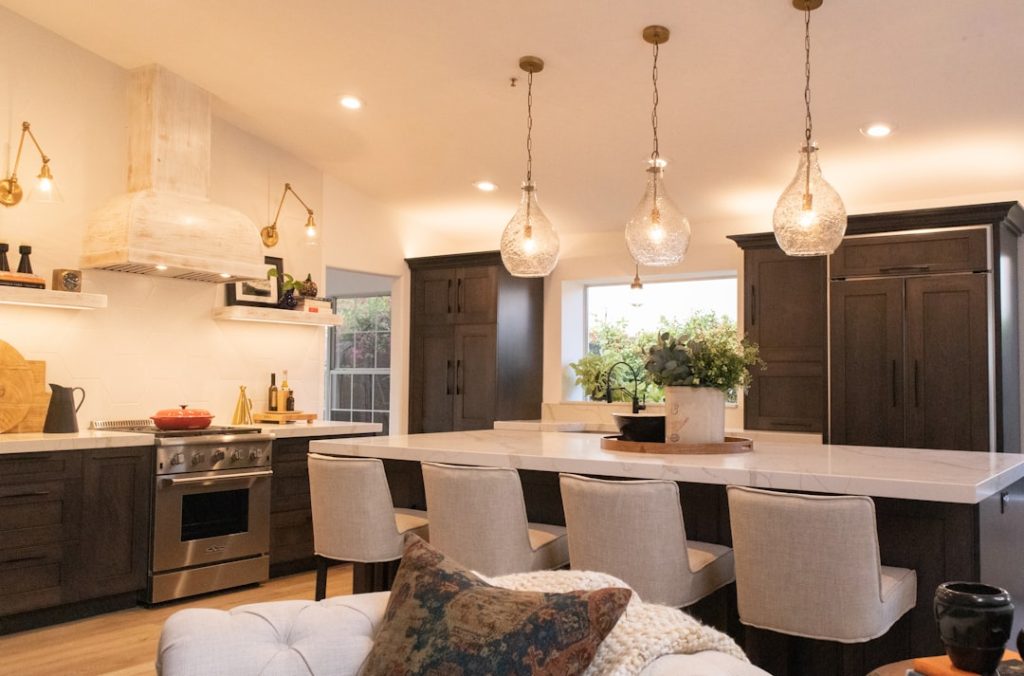The rustic farmhouse kitchen embodies a warm, inviting atmosphere that harkens back to simpler times. Characterized by its use of natural materials, this style often features reclaimed wood beams, distressed cabinetry, and vintage accents that create a sense of nostalgia. The color palette typically leans towards earthy tones, with whites, creams, and soft browns dominating the space.
A large farmhouse sink, often made of porcelain or stainless steel, serves as a focal point, while open shelving displays charming dishware and mason jars filled with pantry staples. The overall design encourages a connection to the outdoors, often incorporating large windows that allow natural light to flood the space. In addition to its aesthetic appeal, the rustic farmhouse kitchen is highly functional.
The layout often includes a central island that serves multiple purposes: food preparation, casual dining, and socializing. This multifunctional space is ideal for families and friends to gather, reinforcing the kitchen’s role as the heart of the home. Accessories such as vintage kitchen scales, wooden cutting boards, and herb planters add to the charm while also serving practical purposes.
The combination of modern appliances with rustic elements creates a harmonious balance that caters to contemporary lifestyles while maintaining a sense of tradition.
Key Takeaways
- Rustic farmhouse kitchens emphasize natural wood textures and cozy, warm designs.
- Modern minimalist woodwork focuses on clean lines and simplicity with functional elegance.
- Vintage French country kitchens feature ornate details and distressed wood finishes for a charming look.
- Scandinavian-inspired woodwork highlights light woods, minimalism, and bright, airy spaces.
- Industrial chic designs combine raw wood with metal elements for a rugged, urban aesthetic.
Modern Minimalist Woodwork
Modern minimalist woodwork emphasizes simplicity and functionality, stripping away unnecessary embellishments to focus on clean lines and open spaces. This design philosophy is rooted in the belief that less is more, allowing the beauty of the materials themselves to shine through. In a minimalist kitchen, cabinetry is often sleek and handle-less, creating a seamless look that enhances the overall spaciousness of the room.
The use of high-quality woods such as oak or walnut adds warmth and texture without overwhelming the senses. Neutral color schemes dominate, with whites, grays, and blacks providing a sophisticated backdrop for the natural wood tones. The minimalist approach extends beyond cabinetry to include furniture and accessories.
A simple wooden dining table paired with understated chairs can create an elegant dining area without cluttering the space. Open shelving may be used sparingly to display only essential items, further promoting a sense of order and tranquility. Lighting plays a crucial role in modern minimalist woodwork; pendant lights with geometric designs or recessed lighting can highlight key features while maintaining an uncluttered aesthetic.
This style not only promotes a serene environment but also encourages mindful living by reducing distractions and focusing on what truly matters.
Vintage French Country Kitchen

The vintage French country kitchen is a delightful blend of rustic charm and elegant sophistication. This style draws inspiration from the picturesque countryside of France, characterized by its use of soft colors, ornate details, and an abundance of natural materials. Distressed wood cabinetry painted in pastel hues or creamy whites creates an inviting atmosphere, while intricate moldings and decorative hardware add a touch of refinement.
The use of natural stone for countertops or backsplashes further enhances the organic feel of this design. Incorporating vintage elements is essential to achieving the French country aesthetic. Antique furniture pieces, such as a weathered dining table or a charming sideboard, can serve as focal points within the kitchen.
Accessories like ceramic dishware, woven baskets, and floral arrangements contribute to the overall ambiance, evoking a sense of nostalgia and warmth. The layout often includes a cozy breakfast nook with upholstered seating, perfect for enjoying leisurely meals with family and friends. The vintage French country kitchen is not just about aesthetics; it embodies a lifestyle that values tradition, comfort, and the joy of cooking.
Scandinavian Inspired Woodwork
| Metric | Value | Unit | Description |
|---|---|---|---|
| Average Wood Density | 650 | kg/m³ | Typical density of wood used in Scandinavian woodwork |
| Annual Production Volume | 1200 | Units | Number of woodwork pieces produced annually |
| Average Project Time | 15 | Hours | Time taken to complete a typical woodwork project |
| Customer Satisfaction Rate | 92 | Percent | Percentage of customers satisfied with the final product |
| Use of Sustainable Wood | 85 | Percent | Percentage of wood sourced sustainably |
| Average Price per Unit | 350 | Currency Units | Average selling price of a woodwork piece |
| Number of Designs Available | 45 | Designs | Variety of Scandinavian inspired woodwork designs offered |
Scandinavian inspired woodwork is synonymous with functionality and simplicity, reflecting the region’s commitment to minimalism and sustainability. This design style emphasizes clean lines and natural materials, often featuring light-colored woods such as birch or pine that brighten up spaces. The use of wood is prevalent in cabinetry, flooring, and furniture, creating a cohesive look that feels both modern and timeless.
Neutral color palettes are complemented by pops of color through textiles or decorative elements, adding warmth without overwhelming the senses. In Scandinavian kitchens, practicality is key. Open shelving allows for easy access to everyday items while also showcasing beautiful dishware or cookbooks.
The layout often prioritizes efficiency, with well-planned work zones that make cooking a pleasure rather than a chore. Incorporating elements like a large kitchen island can provide additional workspace while also serving as a gathering spot for family and friends. Lighting is carefully considered in Scandinavian design; pendant lights with simple designs or large windows that invite natural light are common features that enhance the overall ambiance.
Traditional Shaker Style Cabinetry
Shaker style cabinetry is rooted in simplicity and craftsmanship, originating from the Shaker religious community in the 18th century. This design philosophy emphasizes functionality without sacrificing beauty, making it a popular choice for kitchens seeking a timeless appeal. Shaker cabinets are characterized by their clean lines, flat-panel doors, and minimal ornamentation, allowing them to blend seamlessly into various design styles.
Typically crafted from high-quality hardwoods like maple or cherry, these cabinets are built to last while offering an understated elegance. The versatility of Shaker style cabinetry allows it to adapt to both traditional and contemporary settings. In a traditional kitchen, these cabinets may be painted in soft hues or left in their natural wood finish to highlight their craftsmanship.
In contrast, modern interpretations may incorporate bold colors or sleek hardware for a more updated look. The emphasis on functionality extends beyond cabinetry; Shaker kitchens often feature practical storage solutions such as pull-out shelves or built-in spice racks that enhance organization without compromising aesthetics. This enduring style continues to resonate with homeowners who appreciate quality craftsmanship and timeless design.
Industrial Chic Woodwork Designs

Industrial chic woodwork designs draw inspiration from urban environments, combining raw materials with refined finishes to create a unique aesthetic that celebrates both form and function. Exposed brick walls, metal accents, and reclaimed wood are hallmarks of this style, creating an edgy yet inviting atmosphere in the kitchen. The use of dark woods like mahogany or walnut contrasts beautifully with lighter elements such as stainless steel appliances or concrete countertops, resulting in a dynamic visual experience.
Incorporating industrial elements into kitchen design often involves embracing imperfections rather than hiding them. Reclaimed wood beams can serve as structural features while also adding character to the space. Open shelving made from raw materials allows for easy access to cookware while showcasing unique items like vintage glass jars or artisanal dishware.
Lighting fixtures play a significant role in industrial chic designs; pendant lights with Edison bulbs or metal finishes can enhance the overall ambiance while providing functional illumination. This style appeals to those who appreciate an urban aesthetic combined with warmth and practicality.
Eclectic Bohemian Kitchen Woodwork
The eclectic bohemian kitchen celebrates individuality and creativity through its vibrant mix of colors, patterns, and textures. This design style encourages homeowners to express their personality by combining various influences from around the world. Woodwork in an eclectic bohemian kitchen often features reclaimed or distressed materials that add character and history to the space.
Cabinets may be painted in bold hues or adorned with intricate carvings that reflect cultural influences. Accessories play a crucial role in achieving the bohemian aesthetic; colorful textiles such as patterned rugs or embroidered cushions can soften hard surfaces while adding warmth. Open shelving allows for an artistic display of eclectic dishware, plants, and handmade pottery that contribute to the overall vibe of creativity and comfort.
Layering different materials—such as wood, metal, and ceramics—creates visual interest while maintaining a cohesive look. The eclectic bohemian kitchen invites experimentation and encourages homeowners to curate their spaces in ways that reflect their unique tastes and experiences.
Contemporary Japanese Woodwork Styles
Contemporary Japanese woodwork styles emphasize harmony between nature and design, reflecting traditional Japanese aesthetics while incorporating modern sensibilities. This approach often features clean lines and minimalistic forms that create serene environments conducive to relaxation and mindfulness. Natural materials such as cedar or bamboo are commonly used in cabinetry and furniture, promoting sustainability while enhancing the overall ambiance of the kitchen.
In contemporary Japanese kitchens, functionality is paramount; layouts are designed for efficiency while maintaining an uncluttered appearance. Sliding doors made from wood or glass can create flexible spaces that adapt to different needs throughout the day. The use of natural light is also essential; large windows or skylights invite the outdoors in, fostering a connection with nature that is central to Japanese design philosophy.
Accessories are kept minimal yet meaningful; handcrafted utensils or simple ceramic dishware can serve as both functional items and works of art within this tranquil setting. This style resonates with those seeking balance in their lives through thoughtful design choices that prioritize simplicity and beauty.



